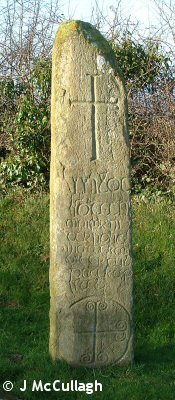The legend inscribed on its front (in Latin, or a mix of Gaelic and Latin) ‘this place Ternoc son of Ciaran the Little, assigned to the keeping of the Apostle Peter’ sets the inscription itself to the second decade of the eighth century of the Christian calendar. There is a distinct air of exorcism about the over-adornment of the stone with crosses and a similarity of the stone to the Long Stone nearby at Ballard and many others in the vicinity and indeed still to be found scattered in remote districts all over Ireland (Ta to John Macan, Oz, for his Guestbook elucidation!). Many of these, including Kilnasaggart, have a distinct phallic appearance and were probably pagan or druidic fertility symbols. This makes it some millennia in situ.
Kilnasaggart Stone

As you know, the Kilnasaggart Stone is the oldest inscribed Christian Standing Stone in Ireland. That of course is less than half the story.
We have no direct evidence of its antiquity for stone is not subject to radio-carbon dating or any of the other scientific methods recently developed. Some scholars ascribe to ancient Celtic Ogham script the diagonal slashes to be found at the back and near the base of the stone.
The stone is signposted in the townland of Carrickbroad within sight of Jonesborough village and at the end of Foughilootra Road (Ta to Anna Kinney, local, for correction here!). Moyry Castle can be seen above it and somewhere nearby was Liscashel fort – before its plundering for building rock – and a now-lost well of remarkably sweet spring water. In an adjacent field there is a ‘wart stone’ with a well of rain water in a hollow in the stone, able to cure warts. More famous as The Gap of The North, this was one-time known as ‘The Glen of the Heifer’. There was once a famous cow here that gave milk freely and without fail. The story goes that a trickster milked the cow into a sieve – through greed or malice is not known – but she stamped her foot on a stone in anger and fled the valley forever. Indeed the imprint of her hoof can yet be seen in a stone located at the base of Kilnasaggart Stone.
There was a parallel tale from the Moyry Pass long ago (Pass of the Salmon) concerning a very long-lived, huge and fierce cat that dwelt hereabouts. When by deception it was finally cornered and dispatched with a blow that severed its head, the decapitated head sprang up and made short shrift of its attacker!
Near to Kilnasaggart Stone are fields known as the Mill Field, the Kiln Field and the Shelling Field signifying industrial activities of bygone eras. Before the introduction of fans to corn mills, shelling was the separation of husks from grain by the process of winnowing.
There is no need to sell the area with such distractions. The natural beauty here is unparalleled and conceals at least seven millennia of continuous human history (from the building of Clontygora Court Cairn 3km away to the British army fortifications still on Foughil mountain above). Earlier excavations revealed in the hedged enclosure before the large stone, a further smaller standing stone some six metres in front surrounded by two concentric circles of graves, the outer being larger than the inner and the feet of the dead pointing towards the centre. Only the odd slab of stone remains visible of all this. Christian or Druidic?
Kilnasaggart means Church of the Priest. There is no corroboration of the existence anywhere about of such a Church but the location some one kilometre for Faughart (of S. Bridget) and two from Meigh (of S. Moninna) and along the path of the great eastern road (Sliath Midluachair) from Tara to Antrim would indicate the likelihood, especially with the site’s ancient religious connotations. It is possible that an early monastery stood here, possibly used for Canons Regular founded by Saint Bridget. When the monks settled at this esteemed site they probably adopted the pre-existing stone to their own ends (a frequent practice where one faith supplants another) and heavily decorated the pagan stone with crosses, some within circles. It is thought that then part of the older Ogham inscription was chiselled off – all a sign of the triumph of Christianity.
There are reports of at least two attempts to remove the pillar stone in the mid nineteenth century. A local planter landlord by the name of Sir John MacNeill sent men to uproot it. The local men were afraid to oppose it lest they be dispossessed: the local women however filled their aprons with stones and ‘clodded’ the workmen away.
A legend grew that there was buried treasure at its base. A local farmer, Owen Murphy rose one morning to find the stone disturbed and evidence of tallow drippings from candles used by the thieves in the night. It was restored. There are stories too of priests in penal times being inserted in spiked barrels and rolled down the hill from Moyry Castle to their death here!
Do yourself a favour. Go visit this beautiful, peaceful and deeply spiritual centre. You will remember it for the rest of your life!